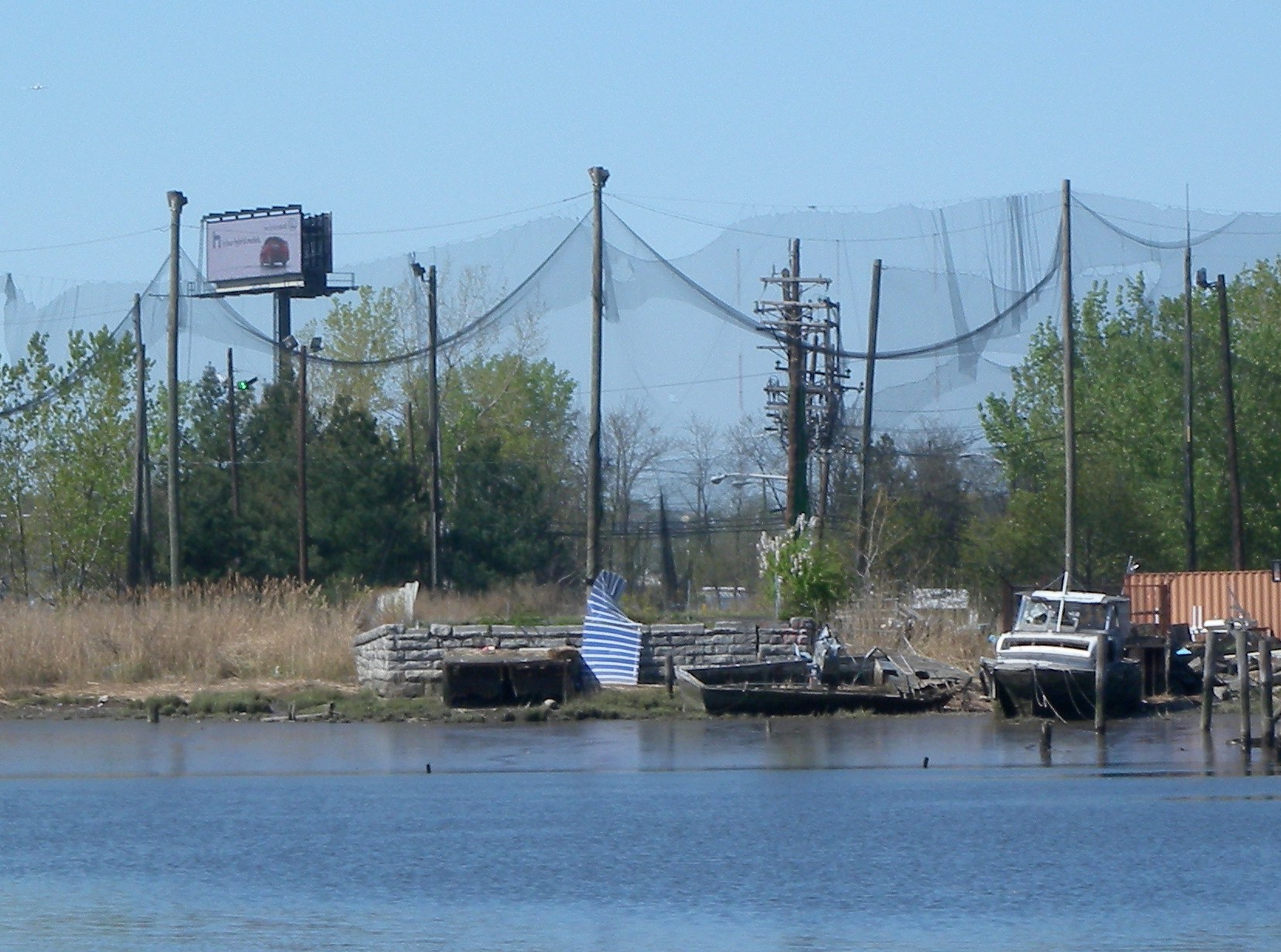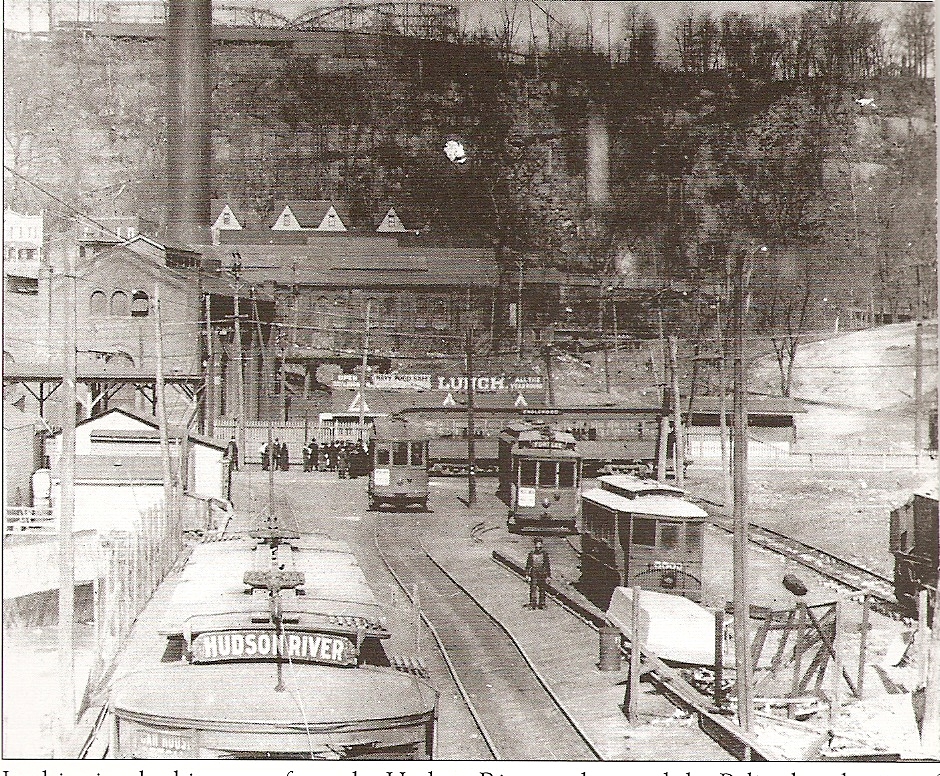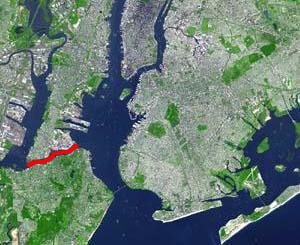|
Paterson Plank Road
Paterson Plank Road is a road that runs through Passaic, Bergen and Hudson Counties in northeastern New Jersey. The route, originally laid in the colonial era, connects the city of Paterson and the Hudson River waterfront. It has largely been superseded by Route 3, but in the many towns it passes it has remained an important local thoroughfare, and in some cases been renamed. History Portions of the road were at times called New Barbadoes Turnpike, from New Barbadoes Neck, the name of the peninsula between the rivers it crossed, the Hackensack and the Passaic. Many plank roads in the United States were developed in the nineteenth century. These roads consisted of wooden boards laid adjacently to prevent coach and wagon wheels from getting bogged down in soft or swampy ground, thereby creating an even surface that would facilitate travel. Normally a toll was charged. This technology was applied to the Paterson Plank Road and similar roads, the Hackensack Plank Road and the Newa ... [...More Info...] [...Related Items...] OR: [Wikipedia] [Google] [Baidu] |
Passaic County Route 601 NJ
Passaic ( or ) is a City (New Jersey), city in Passaic County, New Jersey, Passaic County, in the U.S. state of New Jersey. As of the 2020 United States census, 2020 U.S. census, the city had a total population of 70,537, ranking as List of municipalities in New Jersey, the 16th largest municipality in New Jersey and an increase of 656 from the 69,781 counted in the 2010 United States census.Table DP-1. Profile of General Demographic Characteristics: 2010 for Passaic city , New Jersey Department of Labor and Workforce Development. Accessed December 14, 2011. The United States Census Bureau, Census Bureau's Population Estimates Program calculated that the city's population was 69,633 in 2021, ranking t ... [...More Info...] [...Related Items...] OR: [Wikipedia] [Google] [Baidu] |
New Barbadoes Neck
New Barbadoes Neck is the name given in the colonial era for the peninsula in northeastern New Jersey, US between the lower Hackensack and Passaic Rivers, in what is now western Hudson County and southern Bergen County. The neck begins in the south at Kearny Point in the Newark Bay and is characterized by a ridge (creating the valley of the Passaic) along the west and part of the New Jersey Meadowlands (the flood plain of the Hackensack) on the east. Native Americans and Netherlanders The neck was part of an area called Meghgectecock by the Lenape. It was the territory of the group called the Hackensack. The name of ''masgichteu-cunk'' meaning ''where May-apples grow'', from a moist-woodland perennial that bears edible yellow berries. The name Achter Col was given during the New Netherland era in the mid-17th century, and can be translated a ''rear mountain pass'' or ''behind the ridge'', in reference to the access it provided to the hinterlands beyond the Hudson Palisades ... [...More Info...] [...Related Items...] OR: [Wikipedia] [Google] [Baidu] |
Rutherford Electric Railroad
Rutherford may refer to: Places Australia * Rutherford, New South Wales, a suburb of Maitland * Rutherford (Parish), New South Wales, a civil parish of Yungnulgra County Canada * Mount Rutherford, Jasper National Park * Rutherford, Edmonton, neighbourhood * Rutherford House, in Edmonton, Alberta * Rutherford Library, University of Alberta United Kingdom * Rutherford Appleton Laboratory, Oxfordshire United States * Rutherford, California, in Napa County * East Rutherford, New Jersey * Rutherford, New Jersey * Rutherford, Pennsylvania * Rutherford, Virginia * Rutherford, West Virginia * Rutherford County, North Carolina * Rutherford County, Tennessee People * Rutherford (name), people with the surname or given name ** Ernest Rutherford (1871–1937), 1st Baron Rutherford of Nelson, known as the father of nuclear physics ** Rutherford B. Hayes (1822–1893), 19th president of the United States (1877–1881) Fiction * Rutherford the Brave, a character from Gamehendge ... [...More Info...] [...Related Items...] OR: [Wikipedia] [Google] [Baidu] |
82 Hudson
8 (eight) is the natural number following 7 and preceding 9. In mathematics 8 is: * a composite number, its proper divisors being , , and . It is twice 4 or four times 2. * a power of two, being 2 (two cubed), and is the first number of the form , being an integer greater than 1. * the first number which is neither prime nor semiprime. * the base of the octal number system, which is mostly used with computers. In octal, one digit represents three bits. In modern computers, a byte is a grouping of eight bits, also called an octet. * a Fibonacci number, being plus . The next Fibonacci number is . 8 is the only positive Fibonacci number, aside from 1, that is a perfect cube. * the only nonzero perfect power that is one less than another perfect power, by Mihăilescu's Theorem. * the order of the smallest non-abelian group all of whose subgroups are normal. * the dimension of the octonions and is the highest possible dimension of a normed division algebra. * the first number ... [...More Info...] [...Related Items...] OR: [Wikipedia] [Google] [Baidu] |
Public Service Railway
Transport of New Jersey (TNJ), earlier Public Service Transportation and then Public Service Coordinated Transport, was a street railway and bus company in the U.S. state of New Jersey from 1917 to 1980, when NJ Transit took over their operations. It was owned by the Public Service Corporation, now the Public Service Electric and Gas Company. History The Public Service Railway operated most of the trolley lines in New Jersey by the early 20th century. Public Service lines stretched from northeast New Jersey to Trenton, New Jersey, Trenton, and then south to Camden, New Jersey, Camden and its suburbs. Major parts of the system were: *The Newark Public Service Terminal, a two-level terminal in downtown Newark, New Jersey, Newark. *The North Hudson County Railway, Hoboken Inclined Cable Railway, an elevated railway from Hoboken Terminal up the New Jersey Palisades into Jersey City, New Jersey, Jersey City and south to near Journal Square. *The Newark-Trenton Fast Line, an interurb ... [...More Info...] [...Related Items...] OR: [Wikipedia] [Google] [Baidu] |
Streetcar
A tram (called a streetcar or trolley in North America) is a rail vehicle that travels on tramway tracks on public urban streets; some include segments on segregated right-of-way. The tramlines or networks operated as public transport are called tramways or simply trams/streetcars. Many recently built tramways use the contemporary term light rail. The vehicles are called streetcars or trolleys (not to be confused with trolleybus) in North America and trams or tramcars elsewhere. The first two terms are often used interchangeably in the United States, with ''trolley'' being the preferred term in the eastern US and ''streetcar'' in the western US. ''Streetcar'' or ''tramway'' are preferred in Canada. In parts of the United States, internally powered buses made to resemble a streetcar are often referred to as "trolleys". To avoid further confusion with trolley buses, the American Public Transportation Association (APTA) refers to them as "trolley-replica buses". In the United ... [...More Info...] [...Related Items...] OR: [Wikipedia] [Google] [Baidu] |
Kill Van Kull
__NOTOC__ The Kill Van Kull is a tidal strait between Staten Island, New York and Bayonne, New Jersey in the United States. It is approximately long and wide and connects Newark Bay with Upper New York Bay. The Robbins Reef Light marks the eastern end of the Kill, Bergen Point its western end. It is spanned by the Bayonne Bridge and is one of the most heavily traveled waterways in the Port of New York and New Jersey. Historically, it has been one of the most important channels for the commerce of the region, providing a passage for marine traffic between Upper New York Bay and the industrial towns of northeastern New Jersey. During the colonial era, it played a significant role in travel between New York and the southern colonies, with passengers changing from ferries to coaches at Elizabethtown (now Elizabeth). Since the final third of the 20th century, it has provided the principal access for oceangoing container ships to Port Newark-Elizabeth Marine Terminal, the bus ... [...More Info...] [...Related Items...] OR: [Wikipedia] [Google] [Baidu] |
Paulus Hook, Jersey City
Paulus Hook is a community on the Hudson River waterfront in Jersey City, New Jersey. It is located across the river from Manhattan. The name Hook comes from the Dutch word "hoeck", which translates to "point of land." This "point of land" has been described as an elevated area, the location of which today is bounded by Montgomery, Hudson, Dudley and Van Vorst Streets. The neighborhood's main street is the north- and south-running Washington Street. The waterfront of Paulus Hook is located along the basin of the Morris Canal in a park with a segment of Liberty State Park. The Hudson-Bergen Light Rail has a Paulus Hook stop at Essex Street and the Liberty Water Taxi at Warren Street. The introduction of the light rail and development of office buildings on the Hudson Waterfront have brought more businesses to Morris Street including a number of restaurants with outdoor seating and small neighborhood shops. History The location that today is Paulus Hook originally was called ... [...More Info...] [...Related Items...] OR: [Wikipedia] [Google] [Baidu] |
Bergen Point Plank Road
The Jersey City and Bergen Point Plank Road was a road originally built in the 19th century in Hudson County, New Jersey, United States which ran between Paulus Hook and Bergen Point. The company that built the road received a charter on March 6, 1850 to improve one that had been built in the 18th century. It has subsequently become Grand Street and Garfield Avenue in Jersey City and Broadway in Bayonne. Plank roads were built during the 19th century, often by private companies as turnpike roads, in this case with a tollgate at Communipaw Junction. As the name suggests, wooden boards were laid on a roadbed in order to prevent horse-drawn carriages and wagons from sinking into softer ground on the portions of the road. The road traveled from the waterfront of North River (Hudson River) at Paulus Hook to Communipaw Junction, where a toll was collected. It then ran parallel to the Morris Canal through Greenville to Curries Woods., passing through Bayview – New York ... [...More Info...] [...Related Items...] OR: [Wikipedia] [Google] [Baidu] |
New Jersey Meadowlands
New Jersey Meadowlands, also known as the Hackensack Meadowlands after the primary river flowing through it, is a general name for the large ecosystem of wetlands in northeastern New Jersey in the United States, a few miles to the west of New York City. In the 20th century, much of the Meadowlands area was urbanized, and it became known for being the site of large landfills and decades of environmental abuse. A variety of projects are underway to restore and conserve the remaining ecological resources in the Meadowlands. Geography The Meadowlands stretch mainly along the terminus of the Hackensack and Passaic Rivers as they flow into Newark Bay; tributaries of the Hackensack include Mill Creek, Berrys Creek, and Overpeck Creek. The Meadowlands consist of roughly 8,400 acres (34 km2) of open, undeveloped space in addition to developed areas that had been part of the natural wetlands which were heavily developed by H. Bert Mack and M. Bolero in the 1960s. [...More Info...] [...Related Items...] OR: [Wikipedia] [Google] [Baidu] |
Newark Plank Road
The Newark Plank Road was a major artery between Hudson Waterfront at Paulus Hook (in today's Jersey City) and city of Newark further inland across the New Jersey Meadows. As its name suggests, a plank road was constructed of wooden planks laid side-to-side on a roadbed. Similar roads, the Bergen Point Plank Road, the Hackensack Plank Road and Paterson Plank Road, traveled to the locales for which they are named. The name is no longer used, the route having been absorbed into other streets and freeways. In 1765, an act of the Assembly of the Province of New Jersey stated: A road from New-Ark to the publick road in the town of Bergen, leading to Poulos Hook, and establishing ferries over the two small rivers, Passaick and Hackensack, which makes the distance from Poulus Hook to New-Ark eight miles, and will be a level and good road when the cause-ways are made ; and as said road will be very commodious for travelers, and give a short and easy access of a large country to the mar ... [...More Info...] [...Related Items...] OR: [Wikipedia] [Google] [Baidu] |
Hackensack Plank Road
The Hackensack Plank Road, also known as Bergen Turnpike, was a major artery which connected the cities of Hoboken and Hackensack, New Jersey. Like its cousin routes, the Newark Plank Road and Paterson Plank Road, it travelled over Bergen Hill and across the Hackensack Meadows from the Hudson River waterfront to the city for which it was named. It was originally built as a colonial turnpike road as Hackensack and Hoboken Turnpike. The route mostly still exists today, though some segments are now called the Bergen Turnpike. It was during the 19th century that plank roads were developed, often by private companies which charged a toll. As the name suggests, wooden boards were laid on a roadbed in order to prevent horse-drawn carriages and wagons from sinking into softer ground on the portions of the road that passed through wetlands. The company that built the road received its charter on November 30, 1802. The road followed the route road from Hackensack to Communipaw that was de ... [...More Info...] [...Related Items...] OR: [Wikipedia] [Google] [Baidu] |








